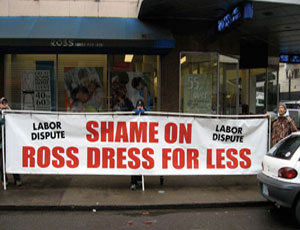The National Labor Relations Board has ruled that the posting of stationary banners by members of a construction union at a secondary employer’s workplace does not violate the nation’s labor laws.

The 3-2 decision, split along party lines, is one of the first major rulings on a controversial issue from the board’s new roster of members. Organized labor considers the case a significant victory.
The board has at least 10 additional banner cases pending. In each case the issue generally comes down to whether banners are protected free speech or illegal boycott at a secondary employer, prohibited by the labor law.
Other, similar cases involving the same issues have covered mock funeral processions and posting of large, inflatable plastic rats near targeted businesses.
Industry groups warn that permitting union bannering at the workplace of an owner—also called a secondary employer—could wreak havoc on construction projects.
The NLRB operated without a quorum from January 2008 to late March 2010, when President Obama recess-appointed two Democrats to join Democrat Wilma Liebman and Republican Peter Schaumber on the panel.
The Senate approved a second Republican and one of the two recess appointees to serve on the board in June. The Senate did not move to confirm the second recess appointee, Craig Becker, who is strongly opposed by business groups.
The Aug. 27 decision, made public on Sept. 2, covers three Arizona cases in which members of the carpenters’ union Local 1506 held stationary, 16-ft-long banners near two medical centers, the Northwest Medical Center and the Thunderbird Medical Center, and a restaurant, RA Tempe. Contractors at work at these business were paying substandard wages and benefits, claims the carpenters’ union.
Two of the banners, placed near the entrance of medical centers, read “SHAME,” while the third urged customers not to eat at the restaurant where work was being performed.
The unions argued that they were exercising their First Amendment rights and were participating in a peaceful demonstration to highlight a labor dispute.
The contractors involved and one of the medical centers, argued that the banners were meant to coerce customers of the establishments into taking their business elsewhere, which the charging parties in the cases said equated to an unlawful secondary boycott under the National Labor Relations Act.
The Board majority—Chairman Liebman, and Members Craig Becker and Mark Pearce—agreed with the unions that the stationary posters were not coercive and were merely an expression of the unions’ First Amendment rights.
“It is a very significant ruling, and it is a precedent-setting ruling,” says Denise Gold, associate general counsel of the Associated General Contractors of America. She says AGC is disappointed with the decision, which her organization believes runs counter to established labor law.
It is also disappointing in light of statements made by Liebman to AGC and others that she would take “real world consequences” of labor actions into account in deciding cases, Gold says.
“This decision has the potential to cause extraordinary disruption of construction projects,” at a time when construction firms are struggling in a difficult economy, she says.
This ruling was one of the last in which Schaumber, who wrote the dissenting opinion along with Bryan Hayes, participated. His term expired Aug. 27.
Currently, there are three Democrats and one Republican sitting on the board.


Post a comment to this article
Report Abusive Comment